Watch a patient’s amazing recovery from knee osteoarthritis through platelet-rich stroma treatment in Chennai India
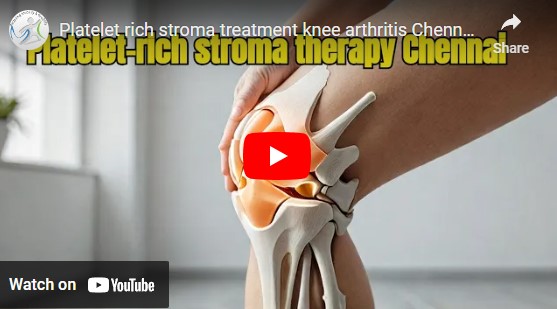

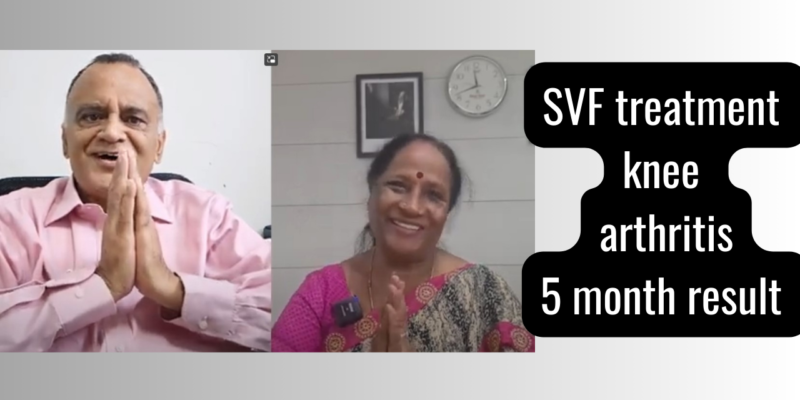
Listen to a patient’s review at 5 months for SVF treatment of knee arthritis. Her condition has tremendously improved. She has improvement of pain score, walking distance, stiffness, gait and collateral improvement in other joints as well.
This lady has a lot of improvement in her condition after five months. Her pain is much less, her stiffness has gone, her gait is straight, and her overall function is better.
Combined SVF and PRP treatment, also known as platelet-rich stroma (PRS) treatment, is a regenerative medicine therapy that uses two components derived from the patient’s own body to treat knee osteoarthritis. Stromal vascular fraction (SVF): This is a collection of cells isolated from fat tissue, such as the abdomen or thighs. SVF contains stem cells, endothelial cells, pericytes, and immune cells. These cells have the potential to differentiate into various cell types and promote tissue repair. Platelet-rich plasma (PRP): This is a concentrated preparation of platelets obtained from the patient’s blood. Platelets contain growth factors and cytokines that promote tissue healing and regeneration.
PRS treatment is a minimally invasive procedure that typically takes about an hour. Here’s a general overview of the steps involved: A small amount of fat tissue is harvested from the patient using liposuction. The fat tissue is processed to isolate the SVF. Blood is drawn from the patient and centrifuged to create PRP. The SVF and PRP are combined to create the PRS solution. The PRS solution is injected into the affected knee joint under ultrasound guidance.
PRS treatment is a relatively new therapy, and more research is needed to confirm its long-term efficacy. However, some studies have shown that it may be effective in reducing pain and improving function in patients with knee osteoarthritis. The potential benefits of PRS treatment include: Reduced pain and inflammation Improved joint function Increased range of motion Slowed progression of osteoarthritis Risks and side effects PRS treatment is generally considered to be safe. However, there are some potential risks and side effects associated with the procedure, such as Pain at the injection site Infection Bleeding Allergic reactions
If you are considering PRS treatment for knee osteoarthritis, it is important to talk to your doctor to discuss the potential benefits and risks and to see if it is right for you. Dr. A.K. Venkatachalam offers consultation at Chennai Meenakshi multi-specialty hospital by appointment. Book yours today. Call the hospital at 044 42938938. PRS treatment is not a cure for osteoarthritis, but it may be a viable option for people who are looking for a non-surgical treatment to manage their pain and improve their quality of life. Here are some additional things to keep in mind: PRS treatment is not covered by most insurance plans. There is limited scientific evidence on the long-term efficacy of PRS treatment. It is important to choose a qualified and experienced provider to perform the procedure.
I hope this information is helpful. Please let me know if you have any other questions. #SVFtreatment #kneearthritis #PRStreatmentchennai
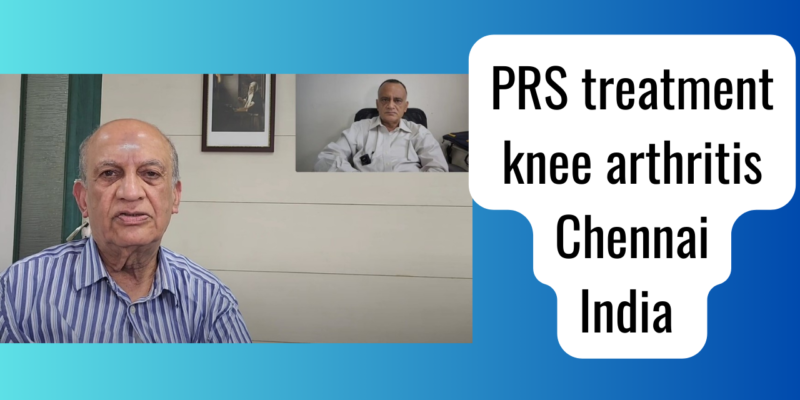
This gentleman sought Platelet-rich stroma treatment knee arthritis Chennai from Dr.A.K.Venkatchalam. Although he had advanced grade 4 arthritis in both knees, the treatment provided pain relief after 3 days.
Osteoarthritis (OA) of the knee, a condition where the protective cartilage wears away, can be a source of chronic pain and limit mobility. While traditional treatments like medication and physical therapy offer relief, they don’t address the root cause. Enter platelet-rich stroma (PRS) treatment, a promising new approach that harnesses the body’s own healing potential.
PRS is a minimally invasive procedure that combines two powerful components:
When injected into the knee joint, PRS delivers a concentrated dose of healing factors:
Platelet-rich stroma therapy is a cutting-edge treatment for knee osteoarthritis that utilizes the patient’s adipose (fat) tissue and Platelet-rich plasma (PRP) to promote healing and reduce pain.
It is done as an outpatient procedure and takes about 2 hours as stated by this patient. He went home soon after and was able to walk without any pain using minimal support.
Plaelet-rich stroma treatment is a safer alternative to knee replacement as said by this patient.
If you want to see more testimonials about biologic treatments for knee arthritis, and shoulder problems, visit Testimonials | Ortho Biologic Surgery Indiahttps://orthobiologicsurgeryindia.com/testimonials-stem-cell-treatment-knee-arthritis/

Stem cell treatment knee arthritis Chennai. See this patient’s testimonial
Fat-derived stem cell treatment for knee osteoarthritis is a relatively new and promising therapy that is being investigated as a potential way to regenerate damaged cartilage and alleviate pain.
Stem cells are undifferentiated cells that have the ability to divide and give rise to specialized cells. They can be found in various parts of the body, including bone marrow, adipose tissue (fat), and umbilical cord blood. Adipose-derived stem cells (ADSCs) are particularly attractive for stem cell therapy because they are relatively easy to harvest and have the potential to differentiate into multiple cell types, including cartilage cells.
The fat-derived stem cells are harvested from the patient’s own body, typically from the abdomen or thigh. The cells are then processed and concentrated in a laboratory. The concentrated stem cells are then injected into the knee joint. Once injected into the knee, the stem cells are believed to have several potential therapeutic effects: Reduce inflammation: Stem cells release anti-inflammatory factors that can help to reduce pain and swelling. Promote cartilage repair: Stem cells may differentiate into cartilage cells and help to repair damaged cartilage. Improve lubrication: Stem cells may help to produce synovial fluid, which lubricates the joint.
There is growing evidence that fat-derived stem cell treatment is safe and effective for knee osteoarthritis. However, more research is needed to determine the long-term efficacy of this treatment. A 2021 study published in the journal Stem Cell Research & Therapy found that intra-articular injection of ADSCs was safe and effective in reducing pain and improving function in patients with knee osteoarthritis. A 2020 study published in the journal Knee Surgery, Sports Traumatology, Arthroscopy found that intra-articular injection of ADSCs with or without platelet-rich plasma was effective in decreasing pain and symptoms in knee osteoarthritis.
The most common side effects of fat-derived stem cell treatment for knee osteoarthritis are injection site pain and swelling. Overall, fat-derived stem cell treatment for knee osteoarthritis is a promising new therapy that has the potential to improve symptoms and slow the progression of the disease.
Dr. Venkatacham is a pioneer in regenerative medicine in India and has extensive experience with SVF therapy. His institute in Chennai is one of the leading centers for the treatment
Where can you get this treatment?
Contact the doctor by filling a form or call the hospital to fix an appointment.
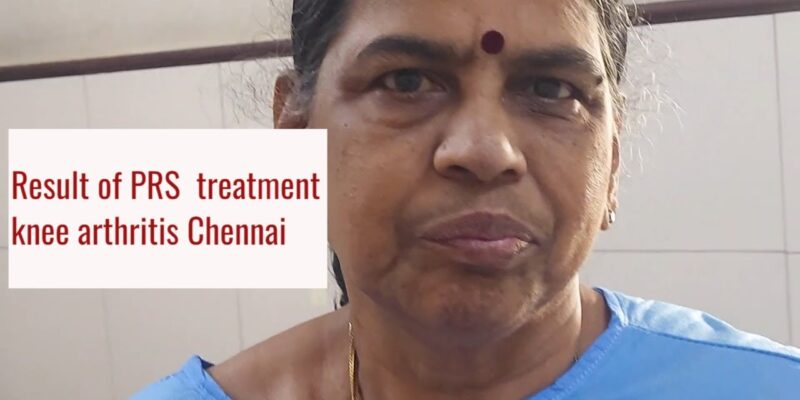
Are you suffering from knee arthritis in Chennai? Try PRS treatment. Watch this video to see how PRS can help you get rid of knee pain and improve your quality of life. PRS treatment is becoming an alternative to total knee replacement among many due to its non-invasiveness, quick results, cost, and durable results. You can see the pre-operative state and post-operative recovery. PRS is a minimally invasive procedure that uses the patient’s stem cells and growth factors to regenerate damaged cartilage and reduce inflammation. The patient was able to walk within a few hours after the treatment with minimal assistance and no pain.
You can see testimonials of more patients here
If you are interested in PRS treatment for knee arthritis, please contact Dr. A.K. Venkatachalam at Madras Joint Replacement Centre. He is one of the leading experts in regenerative medicine and joint replacement surgery in India. Visit his website to learn more about his services and testimonials from his patients.

Platelet-rich stroma treatment for knee osteoarthritis provided amazing pain relief to this lady. Her gait was restored to normal. Listen to her testimonial in this video. To know more about Platelet-rich stroma treatment for knee arthritis, see this post. If you have other orthopaedic problems, see what I can offer here.
Platelet-rich stroma treatment is a biologic combination therapy that combines the regenerative properties of both Platelet-rich plasma (PRP) and stromal vascular fraction (SVF) to treat knee osteoarthritis. PRP is a concentrated source of platelets obtained from the patient’s own blood. Platelets contain growth factors and cytokines that promote tissue healing and regeneration. SVF is a mixture of cells that are extracted from adipose tissue. These cells have the ability to differentiate into various cell types and can help repair damaged tissues1.
Platelet-rich stroma treatment is a minimally invasive procedure that involves the injection of PRP and SVF directly into the affected knee joint. The procedure is safe and well-tolerated, with few side effects reported1. It has been found to relieve the pain of osteoarthritis immediately and its effect can last for a few years. Over a period of time, limited cartilage repair is seen2.
If you want this procedure for yourself, seek an appointment with the doctor at the hospital by filling out the contact form in the home page.
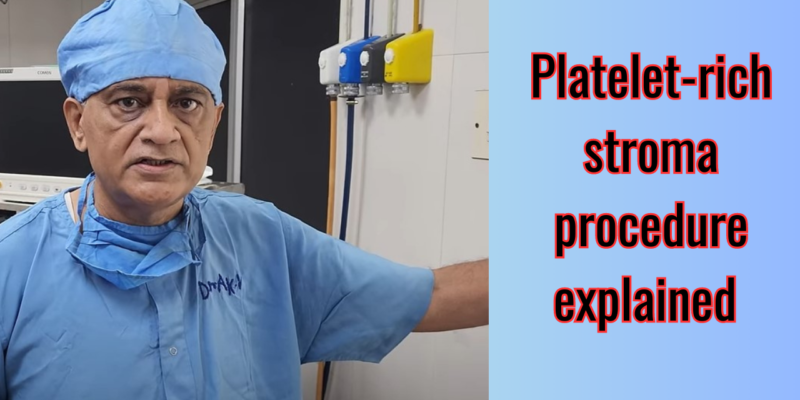
Watch a Platelet-rich stroma procedure performed for a case of knee osteoarthritis. The patient has advanced OA changes as seen on 3T MRI and cartigram.
Platelet-rich stroma (PRS) is a combination of platelet-rich plasma (PRP) and stromal vascular fraction (SVF). PRS includes stromal cells in their matrix with stimulating factors and plays an important role in reducing articular inflammation and signalling cartilage repair in osteoarthritis. It contains SVF obtained from fat. Fat is a better source of multipotential signaling cells than bone marrow. Tissue SVF is combined with Platele-rich plasma (PRP) before intra-articular injection. Fat is harvested by mini liposuction from the thigh, buttocks, or abdominal fat through tiny incisions. The incisions heal naturally without sutures.
PRP is prepared from venous blood. It concentrates platelets several fold times. Platelets contain growth factors which assist in tissue repair.
It is injected into the knee under ultrasound guidance. Ultrasound-guided knee injections are more accurate than blind injections. Keyhole surgery (arthroscopy) or spinal anesthesia is not involved in my procedure. Platelet-rich stroma is a revolutionary procedure to treat osteoarthritis of the knee. Platelet-rich stroma relieves the pain of osteoarthritis immediately and its effect can last for a few years. Over a period of time limited cartilage repair is seen. See the technique of ultrasound-guided PRS injection here. Platelet-rich stroma is preferred by many patients nowadays as an alternative to knee replacement
The procedure is performed under local anaaesthesia. It is injected under ultrasound guidance. Ultrasound-guided knee injections are more accurate than blind injections. Keyhole surgery (arthroscopy) or spinal anesthesia is not involved in my procedure.
No spinal anesthesia is required. Keyhole surgery is not used. Both knees can be done in one sitting. The patient walks into the OR and walks out after the procedure. They experience immediate pain relief. PRS, SVFhttps://www.orthobiologicsurgeryindia.com and PRP are commonly performed biologic injections in my practice. I also perform knee replacements for advanced cases of knee arthritis. ACL reconstruction, and meniscal repair, are the common arthroscopic procedures.
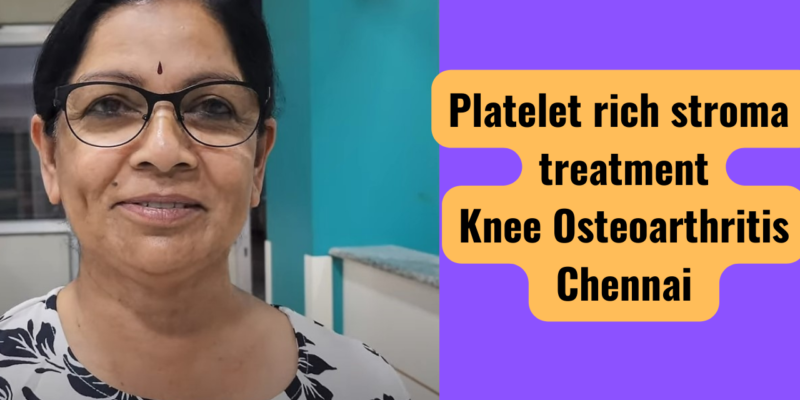
Listen to a patient’s testimonial for platelet rich stroma (PRS) treatment knee arthritis Chennai. This lady was able to walk within a few hours of the treatment.
Platelet-rich stroma (PRS) treatment for knee osteoarthritis (OA) is a promising therapeutic option that has shown significant potential recently. This approach involves the use of the patient’s own blood and tissue which is processed to extract concentrated Platelet rich stroma. This PRS is then injected directly into the knee joint without any key hole surgery under local anaesthesia. Inside the joint PRS can stimulate the body’s natural healing response and help repair damaged tissues.
The effectiveness of PRS and SVF treatment for knee OA has been extensively studied in the literature, with a growing body of evidence suggesting that it can provide significant pain relief and improve function in patients with this condition
The positive result in this patient and others suggest that PRS treatment has significant potential as a non-invasive, low-risk therapeutic option for patients with knee OA. However, it is important to note that more research is needed to fully understand the mechanisms by which PRS treatment works and to optimize treatment protocols for different patient populations.
In conclusion, PRS treatment for knee OA is an exciting new option that holds significant promise for patients seeking relief from this debilitating condition. With further research and refinement, it is likely that PRS treatment will become an increasingly important part of the toolkit of healthcare providers seeking to improve outcomes for patients with knee OA
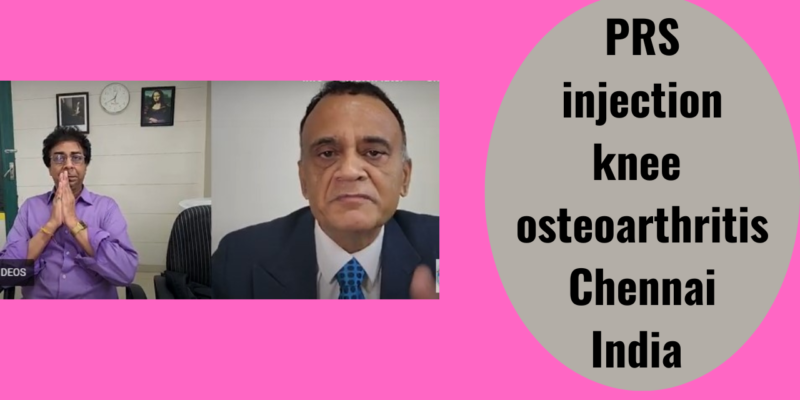
Are you sick of seeing knee replacements fail among relatives and friends? So did this gentleman from Kolkata who was disillusioned with the hardships that his close relatives faced after a knee replacement. He decided to get a platelet-rich stroma ( PRS) treatment for his knee arthritis. Listen to his testimonial here. Many patients have benefited from PRS or SVF treatment in Chennai
Platelet-rich stroma (PRS) treatment in Chennai, India is a cutting-edge therapy for knee osteoarthritis (OA) that utilizes the patient’s own adipose (fat) tissue and PRP to promote healing and reduce pain. The treatment begins with a liposuction procedure to harvest adipose tissue from the patient’s thigh. The tissue is then processed to isolate stromal vascular fraction (SVF), which is a rich mixture of cells that include adipose-derived stem cells, endothelial cells, and other stromal cells. Once the SVF is prepared, it is mixed with platelet-rich plasma (PRP) to yield PRS, which is injected directly into the knee joint, where it can promote healing and repair of the damaged cartilage. The stem cells in the SVF can differentiate into various types of cells, including chondrocytes (cartilage cells), which can help to rebuild the damaged cartilage in the knee joint. Additionally, the SVF can stimulate the production of growth factors and other molecules that promote healing and reduce inflammation. PRP provides growth factors.
PRS treatment is a minimally invasive procedure that is performed on an outpatient basis. Patients typically experience minimal pain and discomfort during the procedure and can return to normal activities within a few days. The effects of the treatment can be seen within a few weeks and may continue to improve over time. Overall, PRS treatment for knee OA is a promising new therapy that utilizes the patient’s own cells to promote healing and reduce pain. It is a safe and effective option for patients who are seeking an alternative to traditional treatments such as surgery or medication. Platelet-rich stroma was injected into both knees of this gentleman for knee osteoarthritis, following which he has made a quick recovery.
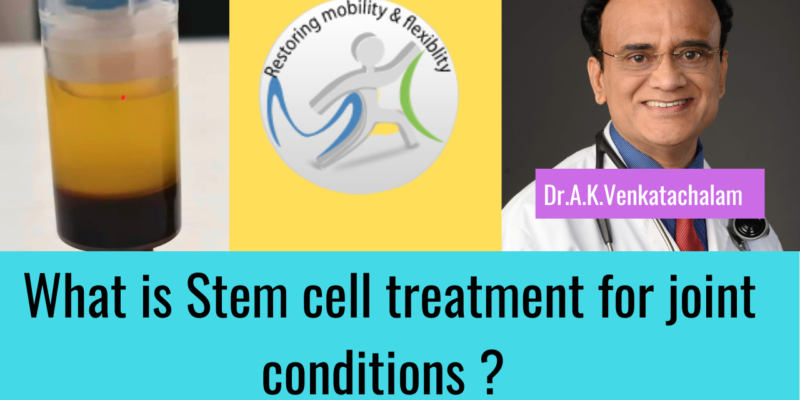
Stem cell treatment knee arthritis Chennai
To know what is stem cell treatment for knee arthritis in Chennai, see this video presentation that was delivered at a medical college in Chennai, India three years ago.
Cells that are capable of regenerating and replicating and repairing tissues are known as stem cells. They are present in every organ and tissue in the human body like skin, fat, bone marrow, muscle, and heart, everywhere, but they are dormant and can be kicked into action by external methods either by the response to a trauma or by seeding the damaged area with stem cells by injection or open procedure.
This is the classification of stem cells. At the top, you have the totipotent embryonic stem cell which is formed by the fusion of the sperm to the ova. This results in a zygote and the formation of a blastocyst which further differentiates into two cells four-cell then the embryo and the fetus and so on. The totipotent embryonic stem cell gives rise to pluripotent embryonic stem cells which form various tissues. These pluripotent stem cells then give rise to multipotent stem cells which are present in every tissue like the lung, pancreas, heart muscle, red blood cells skin muscle bone marrow, and every other tissue. These are not confined to the mesenchymal space.
We aspirate them from fat by liposuction. Then we manipulate them by centrifuging. Then they are ready for injection.
Stem cell treatment for knee arthritis in India by Dr.A.K.Venkatachalam is done as an outpatient procedure. The patient can return home within a few hours. If spinal anesthesia is given, then discharge takes longer.
The cells can also be isolated like before and sent off to a tissue bank where they are cultured and stored. By this, their number is expanded to several million and they can be kept in cold storage for longer periods. Certain tissues have got a half-life but some tissues can be stored for a long time. Their potency decreases after one year. So, when these cells are expanded, they can be returned to the doctor to be re-injected into the patient.
See this procedure here
One can apply it to the cartilage lesion by arthroscopic or open surgery. Here the joint is inspected through an arthroscope, and the area of damage is prepared by shaving and microfracture. Then the cells are made into a paste with fibrin glue and applied to the cartilage lesion. It is shaped with a spatula. Then the joint is put through a range of movements for the glue to set in five minutes. Then the patient is returned to the ward for observation. He/She will remain non-weight bearing and can resume activities full weight-bearing activities after six weeks. This procedure is usually done for single or one or two cartridge lesions. It does not apply to osteoarthritis wherein I use fluoroscopy or ultrasound guidance for injections.
This is a picture of a slide with seeded chondrocytes
They have a trophic effect which means they stimulate growth via the secretion of cytokines and growth factors that is when the cells are injected into a joint these growth factors are released and they have the potency or capability of stimulating adjacent cells in the joint to differentiate and form cartilage. These differentiating cells, when stimulated by growth factors, will go ahead and repair areas of damaged cartilage, and limited cartilage repair are possible; not a complete repair in the case of bone on bone.
The cells possess an immune modulatory effect even when injected even from an allergenic source. They erect a barrier between themselves and the native person’s immune system and perform their function without any interference from the destructive and deleterious effects of the immune system like T cells. They have an anti-inflammatory effect. When injected into swollen inflamed joints, they put a brake on inflammation.
After that, there will be continuous improvement.
Antibiotic effect – There is no need for a person to worry when stem cells are injected. They are not at risk of developing a joint infection like septic arthritis of the knee. This is because of the antibiotic effect present in the stem cells themselves.
Self-replication effect- they can replicate as themselves or replication differentiate into further cell types.
They have an anti-aging effect.
The commonest indication is nonunion. In small non-unions stem cells can be injected which can promote union.
Articular cartilage damage in the knee, shoulder, hip, and ankle joints can be treated with stem cells. When stem cells are injected into areas of cartilage damage, they can repair cartilage. They can also repair osteochondral defects when inserted in the form of a bone plug.
Osteoarthritis -When there is widespread cartilage of ICRS grade 3 grade or 2, stem cells can help to halt the ongoing osteoarthritis process and lead to limited repair. Patients can get sustained pain relief for a few years.
Avascular necrosis is commonly seen in the hip joint, and it is bilateral. It can result from steroid intake, alcohol, Gaucher’s disease, and deep-sea diving. Blood disorders like sickle cell anemia can result in avascular necrosis. Avascular necrosis in the early stages can be treated with stem cells.
Stem cells can also promote wound dealing like in diabetic ulcers or chronic ulcers
I injected Stromal vascular fraction (SVF) derived from fat. Earlier I used bone marrow. Fat has several advantages over bone marrow enumerated here.
Bone marrow has fewer stem cells than fat, Fat contains 500 to 2000 times more MSCs than the same volume of bone marrow. Fat cells have the highest proliferation potential, and the cells are younger than bone marrow. in old older people, it may be difficult to obtain cells from the bone marrow because there is osteoporosis. In addition, fat also contains numerous other regenerative cells that are important to the healing process.
A further advantage of fat is that it is less painful. I can aspirate it from the thigh and the patient can go home within a few hours,
Anticoagulants are not required. If you take bone marrow, then you have to treat it immediately with heparin and inject heparin into the bone to prevent it from clotting while being aspirated. This can result in an overdose or leakage of the anticoagulant solution into the adjacent tissue. Bone marrow aspiration from the posterior part of the iliac crest can result in penetration and spread of the heparin in retroperitoneal space, leading to retroperitoneal hematoma.
Cells derived from fat are a better source for articular cartilage repair.
Some patients have been able to get prolonged pain relief and have postponed knee replacement. The longest follow-up stem cell treatment for the knee is seven years.
See a patient’s testimonial here-
In the short term, they can avoid taking NSAIDs, painkillers, and opioids. They will lead a better quality of life.
So, if you want Stem Cell Treatment for Knee arthritis in Chennai India Dr.A.K.Venkatachalam, click the form, fill it out, and post. You can locate my practice by clicking on this link
Call – 7824003400 or the hospital – 044 42938938
Email -drvenkat@kneeindia.com
